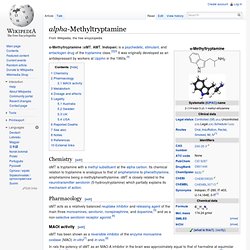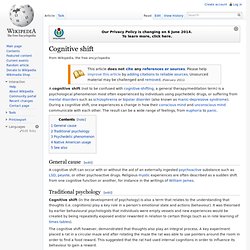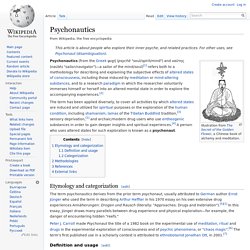

Alpha-Methyltryptamine (IT-290, AMT) Α-Methyltryptamine (αMT, AMT, Indopan) is a psychedelic, stimulant, and entactogen drug of the tryptamine class.[2][3] It was originally developed as an antidepressant by workers at Upjohn in the 1960s.[4] Chemistry[edit] αMT is tryptamine with a methyl substituent at the alpha carbon.

Its chemical relation to tryptamine is analogous to that of amphetamine to phenethylamine, amphetamine being α-methylphenethylamine. αMT is closely related to the neurotransmitter serotonin (5-hydroxytryptamine) which partially explains its mechanism of action. Pharmacology[edit] αMT acts as a relatively balanced reuptake inhibitor and releasing agent of the main three monoamines; serotonin, norepinephrine, and dopamine,[5] and as a non-selective serotonin receptor agonist.[6] MAOI activity[edit] αMT has been shown as a reversible inhibitor of the enzyme monoamine oxidase (MAO) in-vitro[7] and in-vivo.[8] Cognitive shift. General cause[edit] A cognitive shift can occur with or without the aid of an externally ingested psychoactive substance such as LSD, peyote, or other psychoactive drugs.

Religious mystic experiences are often described as a sudden shift from one cognitive function or another, for instance in the writings of William James. Traditional psychology[edit] Cognitive shift (in the development of psychology) is also a term that relates to the understanding that thoughts (i.e. cognitions) play a key role in a person's emotional state and actions (behaviour). It was theorised by earlier behavioural psychologists that individuals were empty vessels and new experiences would be created by being repeatedly exposed and/or rewarded in relation to certain things (such as in rote learning of times tables). The cognitive shift however, demonstrated that thoughts also play an integral process. Psychedelic phenomenon[edit] Native American usage[edit]
LSD. Dimethyltryptamine (DMT) Psilocybin. Psychonautics. Psychonautics (from the Greek ψυχή (psychē "soul/spirit/mind") and ναύτης (naútēs "sailor/navigator")—a sailor of the mind/soul)[1] refers both to a methodology for describing and explaining the subjective effects of altered states of consciousness, including those induced by meditation or mind-altering substances, and to a research paradigm in which the researcher voluntarily immerses himself or herself into an altered mental state in order to explore the accompanying experiences.[2] The term has been applied diversely, to cover all activities by which altered states are induced and utilized for spiritual purposes or the exploration of the human condition, including shamanism, lamas of the Tibetan Buddhist tradition,[3] sensory deprivation,[1] and archaic/modern drug users who use entheogenic substances in order to gain deeper insights and spiritual experiences.[4] A person who uses altered states for such exploration is known as a psychonaut.

Etymology and categorization[edit] Peter J. Psychedelic Shamanism.